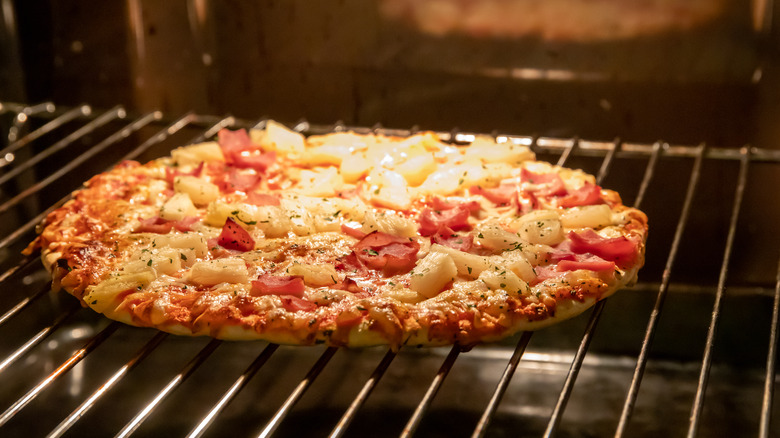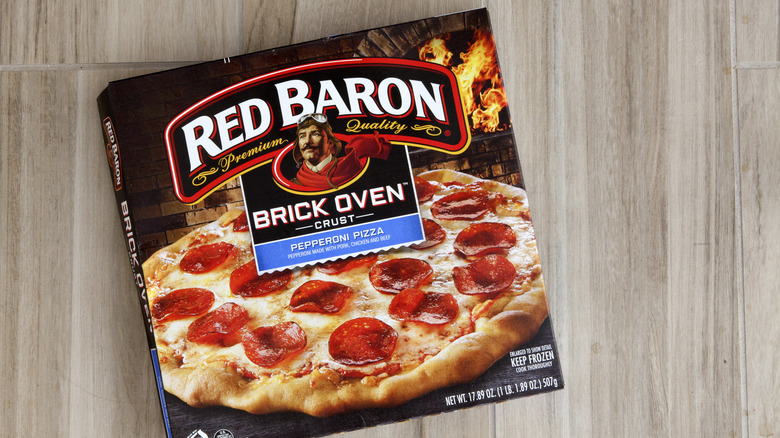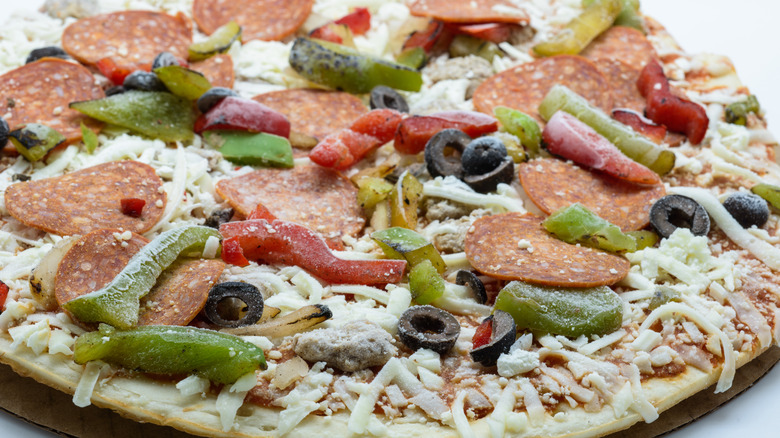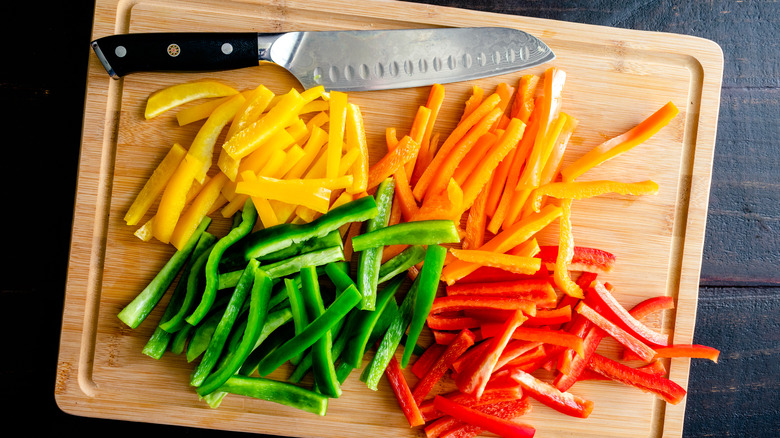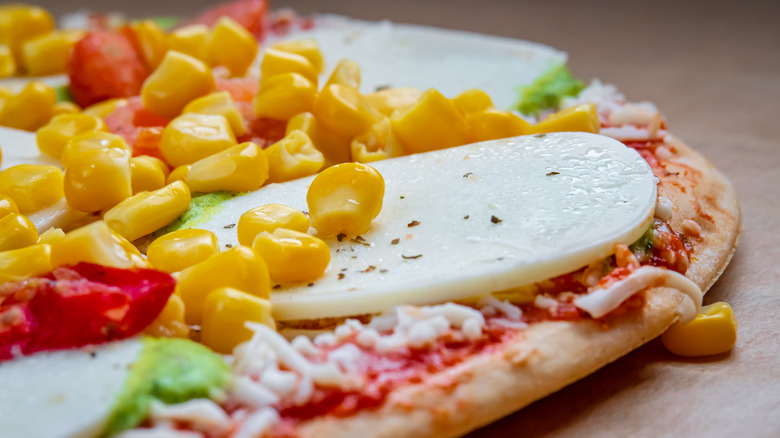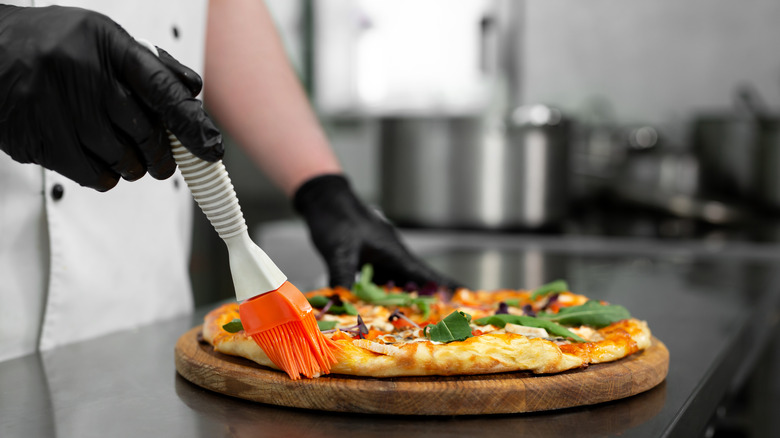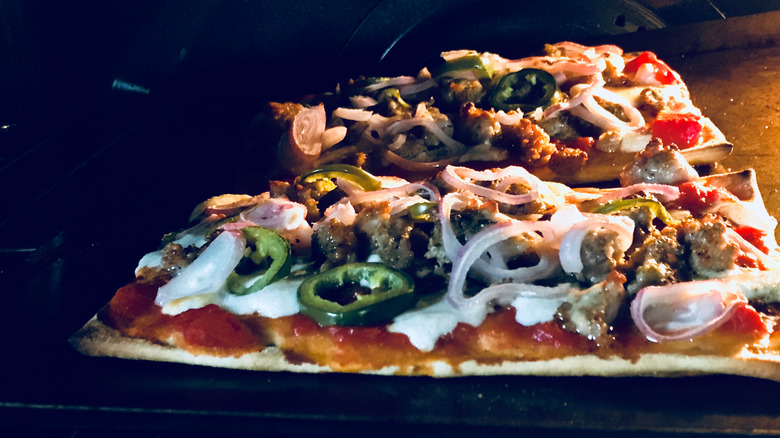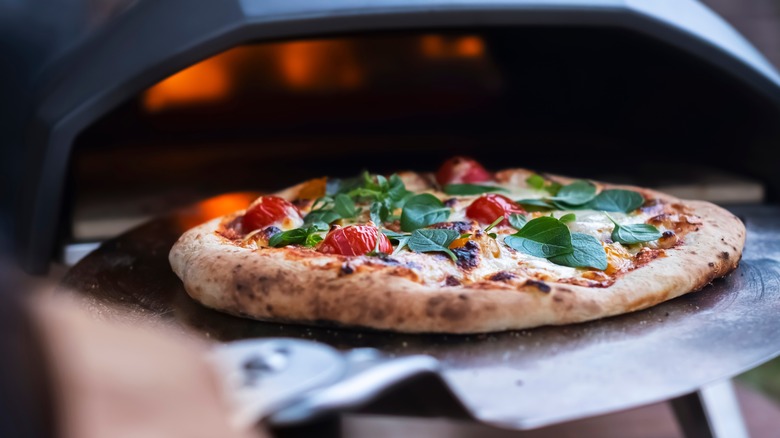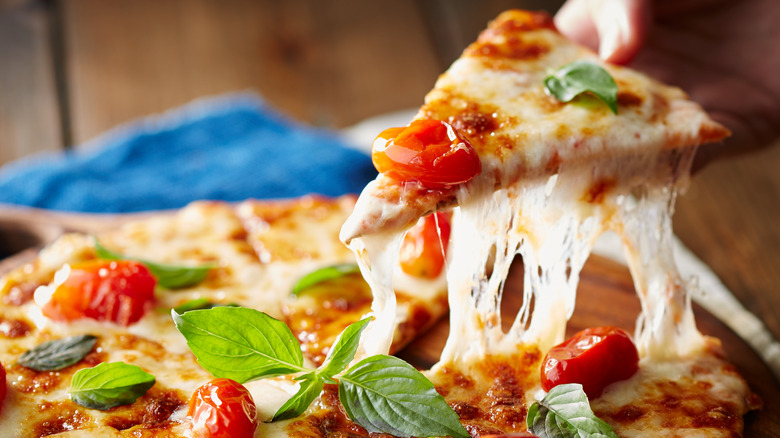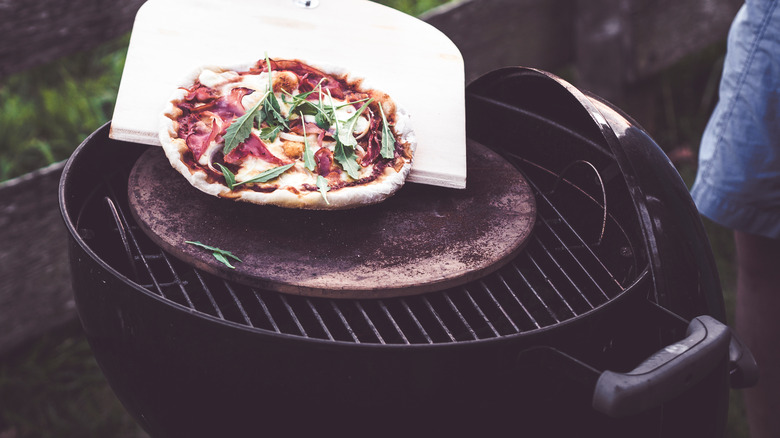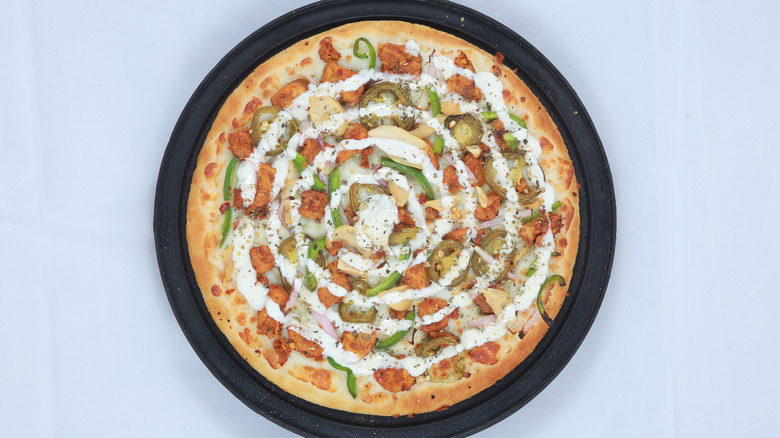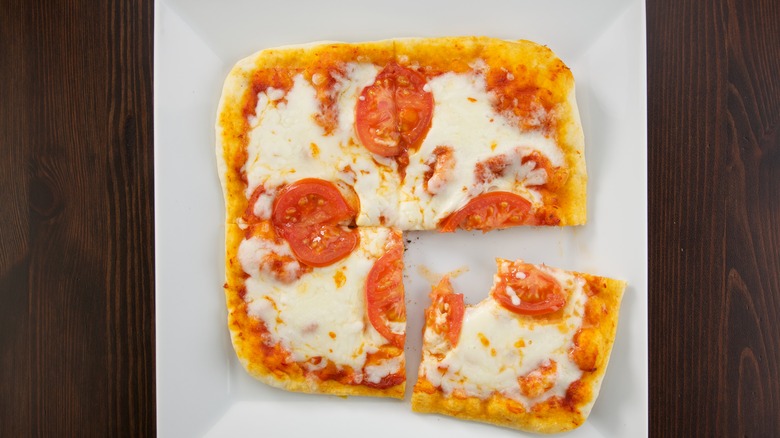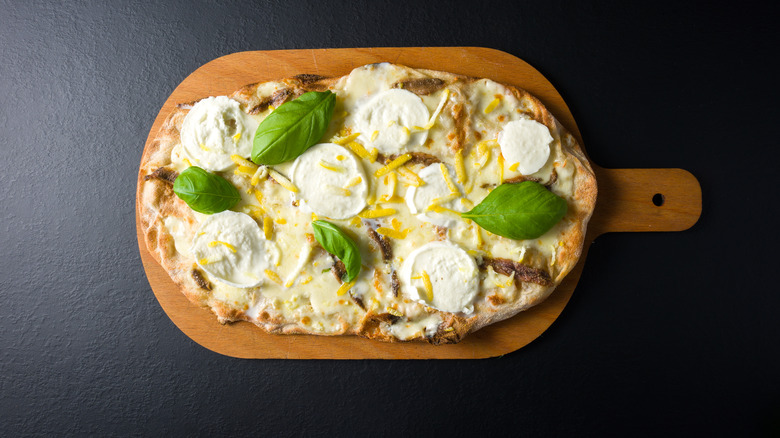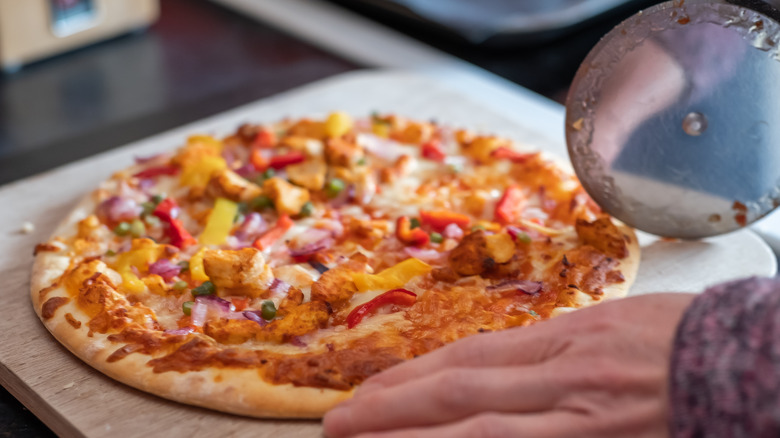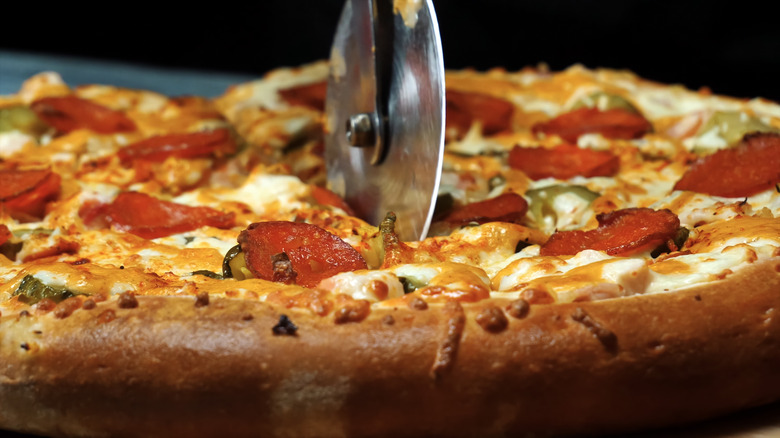The 14 Absolute Best Ways To Elevate Frozen Pizza
Whether you spent your whole life in suburban America or went to a college for any length of time, chances are that you've had a frozen grocery store pizza at least once. Frozen pizza is popular because it's easy to make — simply take it out of the package, pop it in your oven, and you'll have dinner on the table in less than twenty minutes.
The first frozen pizzas were introduced to markets in the 1950s. John Bucci, who applied for the first frozen pizza patent in 1954, argued that sealing the crust and ingredients on the pizza would prevent the pie from becoming a goopy, soggy mess after baking — and the idea meant that people (and most importantly at this time, nuclear families) could make a frozen pizza with minimal preparation. But it wasn't until the Totino's pizza brand emerged in the 1960s that frozen pizza took off. (Totino's remains one of the most popular sellers of frozen pizza and appetizers — specifically, the beloved frozen pizza rolls — to date.
Albeit convenient, frozen pizza can be lackluster in flavor and have a texture similar to that of corrugated cardboard. That's why we're here to reclaim the frozen pizza's reputation with a few simple upgrades.
Start with a reputable pizza brand
When you're walking through the frozen pizza aisle at the grocery store, it can be hard to decipher what kind of frozen pizza you should choose. Besides the question of if you stick with a plain cheese pizza or go with something outrageous, you also have to consider what kind of crust you want. After all, there are usually too many options to choose from!
Some of the frozen pizzas that we love include Tombstone Roadhouse's Loaded Double Down Deluxe Pizza (try saying that three times fast). This pizza has an ample amount of toppings including pepperoni, sausage, peppers, onions, and mozzarella on top of a thin, crunchy crust. If you're looking for a pizza you won't have to manipulate too much, this should be your go-to. If you want to customize your pizza, we recommend going for Screamin' Sicilian Pizza Co's Bessie's Revenge Cheese for its double layer of white cheddar and shredded mozzarella goodness or a Red Baron's classic crust pepperoni pizza for its classic, pizzeria flavor.
Thaw and deconstruct your pizza if you want to get creative
You would think that frozen pizza is just that — cook from frozen. But if you really want to get the most from your frozen pizza, you should instead try thawing it. According to Mel Magazine, one of the reasons that frozen pizza companies direct customers to cook from frozen is to reduce the risk of food-borne contamination during the thawing stage. But, as long as you defrost your pizza in the refrigerator and not in the temperature danger zone (like leaving it on your counter for a few hours), you have very little to worry about.
Besides reducing your cooking time slightly, thawing your pizza out allows you to remove some (or all) of the toppings from your pizza and add your own. After all, it's an arduous process to make your own pizza dough — so using the frozen pizza as a shell for your creative genius may make a lot of sense.
Season and portion your veggies before adding them
Toppings like peppers and onions can get a bit soggy after cooking, but tossing your veggies in olive oil and seasoning before adding them to your pizza will upgrade their crispiness and flavor. We recommend a sprinkle of classic Italian seasoning — you are making pizza after all — or a hint of salt and pepper to accentuate the flavors of the veggies. If you this route, you can add your vegetables directly to the frozen pizza before baking.
One of the benefits of using a frozen pizza for a blank canvas is that you can add whatever toppings your heart (and stomach) desire. Try to pair flavors together from other cuisines and regional dishes that you enjoy. For example, if you like the flavors of Pad Thai, add shredded chicken, thinly sliced carrots, garlic, and a bit of cabbage to your pizza — and top it with a peanut sauce drizzle post-bake.
Super watery vegetables and leafy greens, like spinach and kale, require cooking before adding to the pizza. Otherwise, your pizza will come out of the oven looking more like soup than a pizza. Another important factor in working with vegetables and pizza is how thinly you slice your vegetables. After all, nobody wants to bite into a big hunk of mushroom when they're eating pizza. Zucchini, tomatoes, and mushrooms should be sliced especially thin to prevent super-soaking your pizza.
Layer on extra cheese
Cheese — there's not much else that makes the world better. The cheese tip you need to improve your frozen pizza is to simply add more to compliment the shreds that are already on the pie. We also recommend pulling out your pizza halfway, adding extra cheese, and letting the cheesy goodness melt on top of your toppings. The exact type of cheese you use is up to you and your taste, but you should consider everything from conventional mozzarella to soft cheeses like ricotta or fresh feta.
The next question you might ask is: Can I add too much cheese? With pizza, there is always the chance of overdoing your extras. If you add too many toppings or cheese, you can weigh the pizza down which prevents the layers underneath the toppings from cooking or can lead to your pie feeling more like a dumbbell. A light sprinkle of cheese on top of your frozen pizza should do the trick — there's no need to add the entire bag. When your pizza starts to buckle, you know you've added a bit too much cheese, toppings, or both.
Baste and season the crust before baking
The most visceral memories of pizza we have at a restaurant are biting into the buttery, salty, and flavorful crust of a good pizza. When it comes to frozen pizza, you can emulate the same flavor by adding a quick brush of fat on the crust before placing your pie in the oven. Olive oil is a popular choice for brushing on the outside of pizza because it is neutral in flavor and doesn't emit bitter notes when it reaches a high temperature.
If you're a fan of buttery crust, you might consider making a quick garlic butter to brush on your pizza. You'll want to melt down the butter until it's liquified, add in a bit of minced garlic, and then apply the delicious combo to your crust via a pastry brush. We also recommend adding a sprinkle of sea salt or Italian seasoning to the crust for a salty, savory undertone.
Bake your pizza at a higher temperature than the one listed on the box
One of the reasons it's tough to replicate the magic of pies cooked in a pizzeria is because their ovens run at a particularly high temperature. While your home oven may not be able to reach 700 F, cranking up the heat on your oven helps develop the crispy crust that cooking at a lower temperature just won't reach.
To take your frozen pizza to the next level, take your oven up to the highest bake setting (not broil, and especially not "clean oven" temperature). Bake your pizza for between five to eight minutes, watching closely to ensure the pie doesn't burn. If you're cooking your pizza with this method, you should also methodically layer your toppings so that herbs and leafy green vegetables (like spinach, arugula, or basil) are not directly exposed to the heat. Instead, layer these greens underneath your cheese for a blanket of protection.
Cook your pizza in an outdoor oven
Outdoor pizza ovens are useful for making Basque cheesecakes, roasting meat, or baking bread. But when it comes to frozen pizza, using an outdoor pizza oven is an unparalleled experience. This is because an outdoor oven can reach temperatures that household ranges can't get anywhere close to. If you choose to bake in an outdoor pizza oven, you should always keep a pizza peel handy so you can pull the pizza out if it starts to burn; pizzas cooked in outdoor ovens cook much faster than in standard ovens.
Buying a pizza oven doesn't mean having to drop thousands of dollars on something you use infrequently. We recommend the Ooni Koda 12 — you can purchase gas, wood pellet, or hybrid-heating versions of the oven. The ovens weigh less than thirty pounds so they're easy to transport and move — which makes the Ooni Koda 12 perfect for tailgates, parties, or back porch pizza nights.
Use a pizza stone
Using a stone or steel to bake your pie is one way to ensure a perfectly crisp and evenly cooked pizza crust. When you open your oven constantly to slide in your pizza or check for burning, you unleash a lot of heat. If a pizza stone is preheated in the oven before adding your pizza on top of it, it can hold in the heat of the oven to ensure the bottom of your crust is evenly baked.
You can purchase ceramic (perfect for pizza enthusiasts on a budget), cast iron, or cordierite pizza stones for your oven. If you have the room and cook pizza often they are a great investment since they last you a very long time provided that you avoid washing the stone with soap and protect it from chipping or dropping. You can also use your pizza stone to bake bread, tarts, and bagels — just avoid oily food that may damage the integrity of the stone.
Try grilling your pizza
For better frozen pizza, pull out your charcoal. Cooking your frozen pizza on the grill will help develop delicious dark, burnt notes on the crust, not to mention, it will help to keep your house cool on a summer day. If you want a stronger flavor, you should consider adding herbs to your charcoal before you preheat it. (Preheating is important to ensure that your grill is hot and that your pizza cooks as quickly and efficiently as possible.)
When working with a grill, you'll want to regularly rotate your pizza to ensure that all sides of the pie are cooked. Thicker crust pizzas will take more time than thin crust pizzas, but the average frozen pizza should be ready to eat in 10 to 15 minutes. You'll start seeing the edges of your pizza bubble up and melt, and the bottom of your pizza should be sturdy if you give it a little tap with your knuckle.
Don't neglect the condiments and the sauces
Topping your frozen pizza doesn't just have to include crunchy veggies, gooey cheese, and savory meat — it can also include a delicious array of condiments and sauces. Ranch is one of the most popular dipping sauces for pizza — it pairs especially well with bacon, buffalo sauce, and chicken. You can also upgrade your pizza by swirling ranch directly onto the top after baking; it's the perfect balance of ranch in each bite. If you add the leftover pulled pork from your fridge to your frozen pizza, you can add a drizzle of warm barbecue sauce to the top of the pie to amplify the sweetness and pork undertones of your pie.
If you like bacon on your pizza, you might also consider adding a drizzle of honey or maple syrup to your pie after it's finished baking. Amp up the heat by simmering hot chilis in honey to make a hot honey drizzle for your frozen pizza. The possibilities for sweet and savory combinations with the array of dipping sauces at your disposal.
Add toppings to your pizza after its finished cooking
There may be a lot of merit to adding toppings to your frozen pizza before you bake it. But if you want more fresh flavors and unique textures, you should consider adding toppings to your pizza after it's done cooking. A sprinkle of freshly grated Parmesan cheese and baby arugula are two of our favorite toppings to add to a pizza right out of the oven.
If you're deciding when to add your respective toppings, you should consider two things: water content and how cooking alters the flavor of the topping. For meat like sausage and bacon, you'll want to cook the toppings ahead of time to ensure that they are both ready to eat in the short time it takes your pizza to bake, as well as how the flavors meld with the cheese and sauce on your pizza. If you want to be creative and add pickles to your pizza (which we can neither condone nor promote), you'll want to add the slices to your pizza after baking to ensure that you get the most pickle-forward flavor.
Zest lemon for a pop of freshness
Here's a simple but spectacular trick: Zesting lemon onto frozen pizza not only brings a bright, tart flavor but it also amplifies the savoriness and saltiness of your other chosen toppings. You'll want to add a bit of zest using a Microplane grater and consider a squeeze a bit of juice out of a freshly sliced halved lemon onto your pizza after it's finished baking. If you don't want a direct, pungent citrus flavor, you can also use lemon-infused olive oil on your pizza after it's baked.
This hack works best for white pizzas which are made with an olive oil base rather than tomato sauce. We love pairing lemon juice with fresh basil, fennel, or fruits like sliced figs or apples. Mozzarella and ricotta are easy to pair with lemon because the acid in the citrus balances out the fats in the cheese.
Let the pizza sit for a few minutes before diving in
It's been a long, hard day at the office and you're finally pulling out the frozen pizza you've been waiting all day for out of the oven. It may be tempting to slice right into the pie and dig in, but you should refrain. You should let the frozen pizza rest after baking to allow the flavors of the pizza to meld together a bit more. Plus, cutting into the pie too early will mean that your toppings get jostled around and stick to the blade of the cutter easier than if you waited just a little bit for the cheese to cool.
You won't have to wait for an inordinate amount of time to enjoy your frozen pizza — hold off for about two minutes before slicing. It's the perfect amount of time to find a good Netflix show and settle in before enjoying your well-deserved slice.
Always use a pizza cutter to slice your pie
If you frequent the frozen pizza aisle at the grocery store or if you make homemade pizza at home, you need to invest in a good pizza cutter. There are three different types of pizza cutters you can purchase: wheels, rockers, and scissors. Each has its own independent merits and respective ease of use. Wheels and sturdy rockers work for well for cutting a standard slice while scissors should be considered for divvying up a square pie. You'll also need to be sure to maintain the sharpness of the blade to ensure an even cut every time — and if you have good luck, you'll cut even slices on the first try.
Pizza cutters are especially sharp so they can easily cut through layers of crust, toppings, and cheese without scraping all the ingredients off in the process. Depending on the type of pizza cutter you have, you can also use it to cut quesadillas, dough, waffles, or flatbreads.
